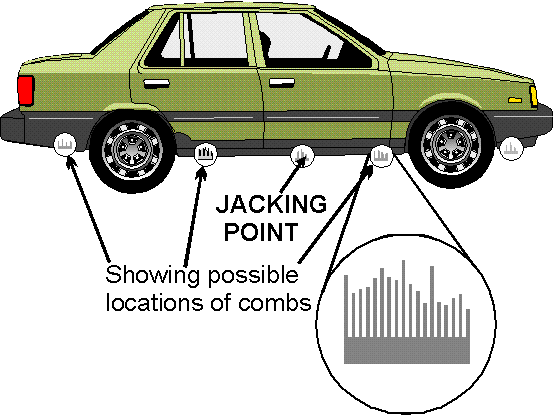
The comb's teeth are of varying lengths. The selection of lengths is
chosen in advance to be different from all other similar combs.
This device is as simple as it could
be. It consists of a comb stamped out of sheet steel and fixed
in a sealed void within a car's (or any other object's) structure.

Each tooth of the comb will vibrate
to some degree when excited by a vibration stimulus. A detector
designed to receive the vibrations from all the teeth of the comb
at once can convert the vibration frequencies received into an
indentification number.
A typical comb would be around 6 centimetres long from the fixing
edge to the end of the longest tooth. The maximum tooth length
would be around 4 centimetres and the shortest around 2 centimetres.
If the tooth lengths are stepped at one millimetre intervals,
21 different tooth lengths are possible. A typical comb would
have 12 teeth. With 21 different lengths and 12 teeth, more than
100 billion combinations are possible.


A car could be fitted with two or more combs so that at
least one comb would be left undamaged in the event of an accident.
In the event that a car had been constructed from two cars that
were written off, using the front half of one and the back half
of another, the identity combs would show that parts of two cars
were used.
The identity comb can be set into vibration by a gentle tap on
the car's bodywork near where the comb is located. Typically this
would be near a strengthened part near a jacking point. The gentle
tap could be administered by the detector unit. A contact microphone
in the detector will pick up the vibrations from the comb and
provide an electrical signal for further processing.
The musical notes produced by the vibrations of the comb's teeth
can be separated and identified by a spectrum analyser. The note
combination is then digitised for storage in a memory unit.
A typical compact disc could hold more than 100 million identification
numbers. If a compact disc drive is incorporated in the detector
unit, the unit could detect a car's identity within a few seconds.
New compact discs are easy and to produce so frequent updating
is no problem.
The identity comb has the advantage that it cannot be removed
from a car's structure without causing major damage. If two or
more combs are fitted in a car when it is manufactured, removal
of one set of combs and replacement by another set would be uneconomic
for any car thief. A car with no combs or with unknown comb numbers
would be instantly identifiable as having been stolen. It is a
simple matter to arrange that combs are allocated to cars in a
random series and the comb number fitted to a car is recorded
with the chassis and engine numbers. The combination of numbers
would make forgery of a set of numbers almost impossible.
The vibrations of a comb's teeth caused by a car's movement will
make the whole car's body vibrate a minute amount. These vibrations
may be detectable remotely by the use of a laser. If this can
be made to work, all cars passing a detection station could be
identified automatically. A network of detection stations could
then be used to locate stolen cars very quickly. Detection stations
at ports could foil attempts to import or export stolen cars
Originally designed in April 1993. An attempt to get a working
patent then did not get very far.
 Thank
you for visiting Wilf's Car Comb Page.
Thank
you for visiting Wilf's Car Comb Page. 